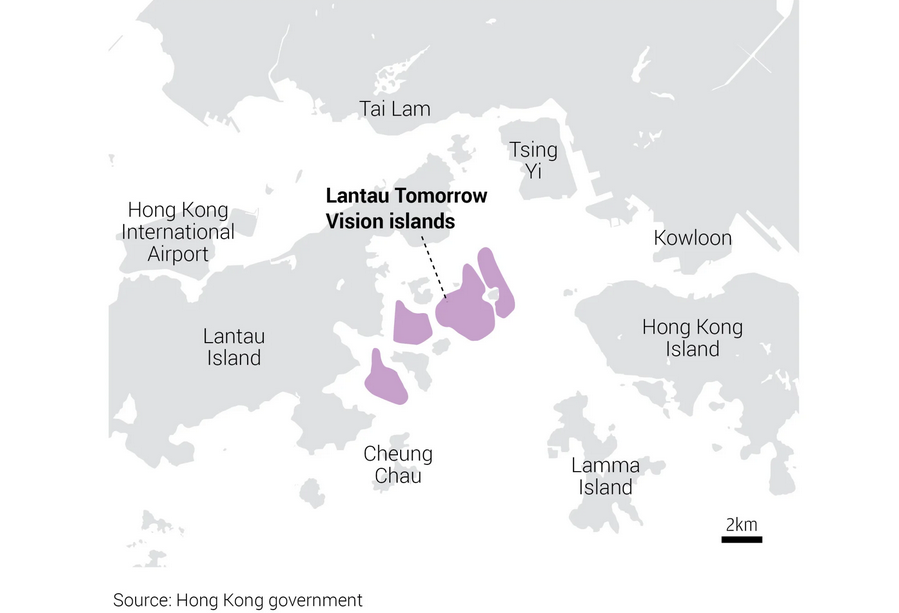Hong Kong News

With city in the red, Ip is not wrong to question costly Lantau vision
Infrastructure mega-projects are controversial. They consume nail-bitingly large amounts of taxpayer money, invariably bump into unforeseen technical problems and often inflict environmental harm. They are always completed late and over the budget.
And there are always groups who don’t share the project’s vision and will work to block its progress. Such groups, often self-interested, make it difficult for political decision-makers to gauge the largest community interest and weigh the costs and benefits.
Hence the revived fuss, triggered by veteran politician Regina Ip Lau Suk-yee, about the Lantau Tomorrow Vision project, which Chief Executive John Lee Ka-chiu seems set on protecting and Financial Secretary Paul Chan Mo-po is preparing to fund.
Ip has suggested that a second mega-project, the Northern Metropolis, which focuses on developing the communities spanning our boundary with Shenzhen and strengthening Hong Kong’s links with our Greater Bay Area hinterland, should instead be prioritised.
At present, the government says we need both mega-projects. The controversy seems to have little to do with the validity of her concerns, and more to do with the political awkwardness of someone so close to the Hong Kong leadership questioning a high-profile project directly championed by our chief executive.
The Lantau project is, without question, visionary. It was initially championed by developer Gordon Wu in the 1980s, who saw the new artificial islands as stepping stones to Lantau’s development, linking Hong Kong to the cities west of the Pearl River: Macau, Zhuhai, Zhongshan, Jiangmen, up to Guangzhou.

The Lantau vision, in its most recent form, also addresses Hong Kong’s most pressing challenge: adequate housing for our city’s 7.3 million people. It is neither politically, socially nor economically acceptable that a city as wealthy as Hong Kong should suffer six-year queues for public housing, with more than 200,000 living in squalid subdivided housing, and home prices beyond the reach of a large majority of ordinary people.
The housing problem must be urgently addressed of course. Procrastination has stymied progress for more than a decade, and another decade cannot pass without resolution. Lee has flagged himself as a “result-oriented” leader. Projects like the Lantau Tomorrow Vision and Northern Metropolis are important tests of his credibility.
But with so much taxpayer money at stake, there needs to be clarity on whether there are cheaper, equally effective ways to resolve our housing crisis.
The budget for the Lantau mega-project is HK$624 billion, with many suggesting that inflation and overruns will lift this to above HK$800 billion. It would ultimately provide 210,000 flats, 70 per cent of them public housing in an early proposal, and accommodate around half a million people.
At soonest, it will welcome residents in a decade, with its train links not ready until maybe 2038. This does little to lessen the housing crisis in the short to medium term, which calls on the government to supply over 30,000 units a year.
In comparison, the Northern Metropolis mega-project spans 300 sq km along Hong Kong’s boundary with Shenzhen. It embraces Tin Shui Wai, Fanling, Sheung Shui and several new development areas, providing 900,000 new homes for about 2.5 million people over the next 20 years. It will be home to a “technopole” in San Tin, more than 16 times bigger than our current science park. It will include a new cross-border rail link to Qianhai, and a train line linking the new communities.
There is as yet no clear estimate of the cost, but there is confidence it will be significantly cheaper than the Lantau mega-project.
While the Northern Metropolis does not resolve our immediate housing problems either, there is a strong case that it has merits that the Lantau mega-project lacks. It will provide homes to almost five times as many people, in a much more natural location, and strengthen our links in the Greater Bay Area.
The hi-tech hub will link naturally with Shenzhen and its deep reservoir of hi-tech manufacturing. It will provide a natural opportunity to deal with the extensive tracts of “brownfield” land that blight the environment of our northern New Territories.
So Ip is not wrong to argue that the Northern Metropolis should have priority if choices are needed. After three dreadful years for the Hong Kong economy, she is also not wrong to press our officials hard on affordability. Financial Secretary Chan expects a deficit of HK$139.8 billion for the financial year just ended, with reserves pared to HK$817.3 billion. In his latest budget, he predicted another deficit for this financial year of around HK$54 billion.
Revenues last year were down by 15.7 per cent, due to a fall in land premium and revenue from stamp duty. Spending was up by 16.8 per cent because of “countercyclical” measures such as the consumption vouchers and anti-epidemic spending.
With swings as large as this, a global recession looming and no strong signals that economic recovery will buoy us any time soon, Ip is well justified in demanding that officials examine costs carefully.
Chan has insisted that the Lantau mega-project’s awesome cost could be offset by land revenues, and suggested bonds and public-private deals could help keep taxpayer costs down. But with debt interest rates rising sharply and land revenues looking vulnerable, Ip is not wrong to keep Chan’s fiscal feet to the fire.
Most of us will never have the expertise or data to judge whether the Lantau mega-project is essential. We rely on the likes of Ip to press such questions for us, whether they are “embarrassing” for the chief executive or not.











